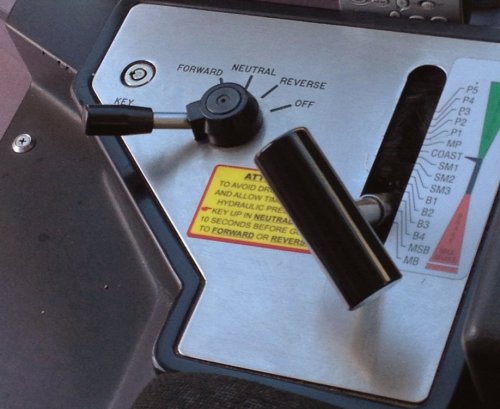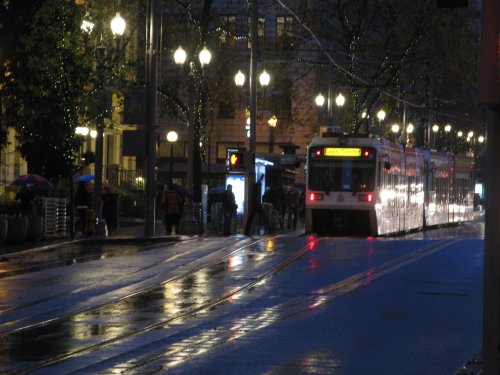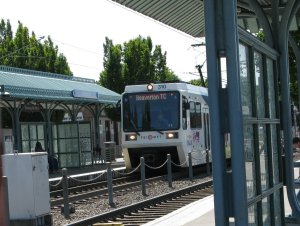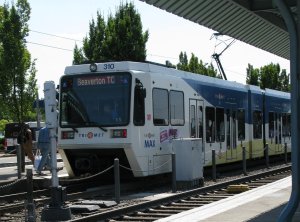Oh good, a technical question. Plus an excuse to use a bunch of pics.
Question: What are those signs at Gateway that say “Reverser in Neutral” for?
First, a little bit of train anatomy. Here is what’s known as the “master controller” (no, not that one), this particular one is in a Type 2.
 The master controller: reverser on left, motoring drum handle on right
The master controller: reverser on left, motoring drum handle on right
When starting up a train, operators move the reverser handle first into neutral, rather than to forward or reverse. This essentially lets the train boot up properly. If I understand it correctly (this is getting into more maintenance than operations), there’s also a built-in daily failsafe in the trains that runs a computer check the first time a train is keyed into after midnight, which checks the track brakes and sand, so leaving the train in neutral while it runs this test prevents excessive sand dumping. Anyway, once that’s done, the reverser is used to select the direction of travel.
- “Forward” is what the public is used to seeing, where the train’s headlights and cyclops (aka railroad light) in the front of the train are lit and the train is moving forward.
- “Reverse” makes the train able to back up, and so this almost never done since you can’t see where you’re going. This is not to be confused with running reverse traffic, where the train is going the “wrong way” down the tracks but with the operator facing the same direction the train is moving. The only time passengers would be likely to see a train backing up is when cars need to be uncoupled on the mainline.
- When the reverser is in “neutral” you can’t move the train in any direction, but the train still recognizes that cab as the active cab. The headlights & cyclops will go dark, and will be lit again when the reverser is moved to a direction of travel.
- “Off” – turns the train propulsion systems off, but does not affect auxiliary power (this is how an operator can leave the train at the end of the line but the lights, HVACs, and doors will all still have power). Type 4s don’t have an off position; neutral serves the same function.
In both directions at Gateway, operators move the reverser into neutral while servicing the platforms. Here’s a westbound red line train coming into the pocket track at Gateway (reverser in forward) and then stopping at the signal to service the platform (reverser in neutral).
Putting the reverser into neutral here is a communication to buses. The layout of Gateway has buses crossing the tracks on either end of the platforms, so putting the train in neutral darkens the forward lights and lets buses know that it’s safe to cross. Elsewhere on the alignment, operators will also put trains in neutral to let emergency vehicles pass (as well as funeral processions, but those aren’t as common).
 Train in neutral at Pioneer Courthouse (not sure why, I’m assuming that an emergency vehicle was passing through).
Train in neutral at Pioneer Courthouse (not sure why, I’m assuming that an emergency vehicle was passing through).
Not related to the reverser, but for those of you looking at the propulsion and braking modes in the second picture and are curious, the range of propulsion acceleration is 0.3 mph/sec in P1 to 3 mph/sec in P5. That would be a very rough start, so trains don’t leave platforms in P5. The braking has the same range of deceleration from B1 through MSB (maximum service brake, the highest level of braking used in normal service). On the bottom is the maximum brake, reserved for emergency stopping as it decelerates at a rate of 3.2 mph/sec. In the middle, MP is the minimal amount of propulsion you can use, coast is neither braking nor propulsion, and SM1-SM3 are similar to a car’s cruise control, designed to hold the train at different maximum speeds without going over.




Yay technical posts, Now I can confuse my friends even more! “What do you mean the train is at p1 chris?!”
Correct me if I’m wrong but if you’re in the active cab, keyed in, and put it in reverse, the lights outside of your cab will go to red and the lights at the opposite end of the train will light up as if *it* was the active cab. Right?
Yep, that’s correct, the cyclops is lit in the direction of the train’s movement.
Also, as related to the description of rates of acceleration and braking, good to point out/remember that on the type 1 vehicles that propulsion modes 1 through 3 (P1 P2 and P3) the motors are activated/controlled in series. The jump from P3 to P4 changes to parallel control of the motors. The rest of the fleet doesn’t have this issue due to the AC motors used on those cars. (The type 1 cars are propelled by DC motors.)